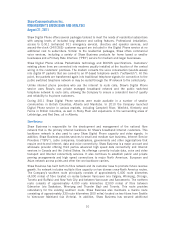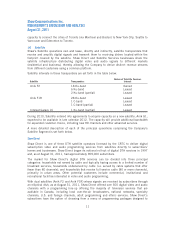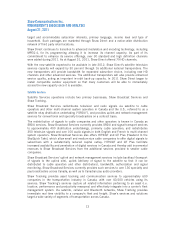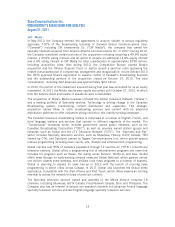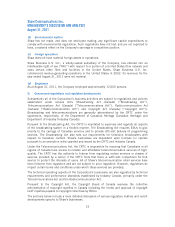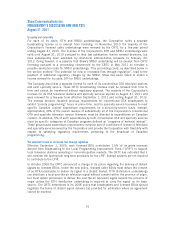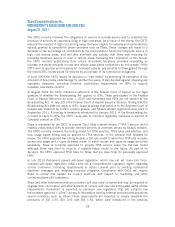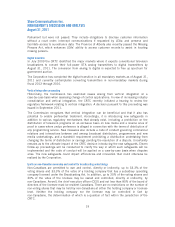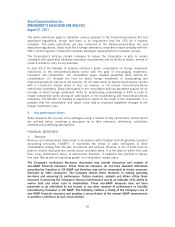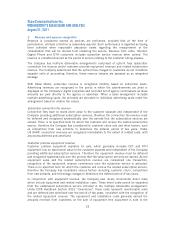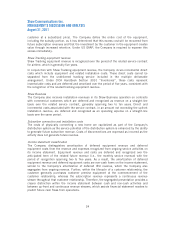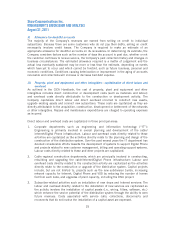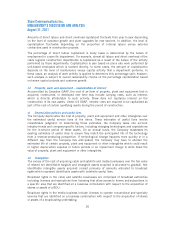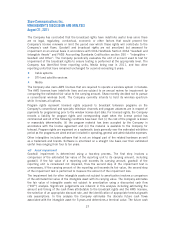Shaw 2011 Annual Report Download - page 23
Download and view the complete annual report
Please find page 23 of the 2011 Shaw annual report below. You can navigate through the pages in the report by either clicking on the pages listed below, or by using the keyword search tool below to find specific information within the annual report.Shaw Communications Inc.
MANAGEMENT’S DISCUSSION AND ANALYSIS
August 31, 2011
Parliament but were not passed. They include obligations to disclose customer information
without a court order; intercept communications if requested by LEAs; and preserve and
facilitate access to surveillance data. The Province of Alberta also recently passed the Missing
Persons Act, which enhances LEAs’ ability to access customer records to assist in locating
missing persons.
Digital transition
In July 2009 the CRTC identified the major markets where it expects conventional television
broadcasters to convert their full-power OTA analog transmitters to digital transmitters by
August 31, 2011. The conversion from analog to digital is expected to free up spectrum for
government auction.
The Corporation has completed the digital transition in all mandatory markets as of August 31,
2011 and currently contemplates converting transmitters in non-mandatory markets during
fiscal 2012 through 2016.
Vertical integration proceeding
Historically, the Commission has examined issues arising from vertical integration on a
case-by-case basis when assessing change of control applications. In view of increasing industry
consolidation and vertical integration, the CRTC recently initiated a hearing to review the
regulatory framework relating to vertical integration. A decision pursuant to this proceeding was
issued in September 2011.
The Commission recognizes that vertical integration can be beneficial and that it also has
potential to enable preferential treatment. Accordingly, it is introducing new safeguards in
addition to various regulatory mechanisms that already exist, including a prohibition on the
distribution of television programs on an exclusive basis on new media and a reverse onus of
proof in cases where undue preference is alleged in connection with the terms of distribution of
any programming service. New measures also include a code of conduct governing commercial
relations and interactions between and among broadcast distributors, programmers and new
media undertakings, and a standstill requirement prohibiting a distribution undertaking from
changing the terms of distribution or carriage pending the resolution of a dispute. Uncertainty
remains as to the ultimate impact of the CRTC decision introducing the new safeguards. Eleven
follow-up proceedings will be conducted to clarify the way in which such safeguards will be
implemented and the code of conduct will be applied on a case-by-case basis when disputes
arise. The new safeguards could impact efficiencies and innovation that could otherwise be
realized by the Corporation.
Limits on non-Canadian ownership and control for broadcasting undertakings
Non-Canadians are permitted to own and control, directly or indirectly, up to 33.3% of the
voting shares and 33.3% of the votes of a holding company that has a subsidiary operating
company licensed under the Broadcasting Act. In addition, up to 20% of the voting shares and
20% of the votes of the licensee may be owned and controlled, directly or indirectly, by
non-Canadians. As well, the chief executive officer (CEO) and not less than 80% of the board of
directors of the licensee must be resident Canadians. There are no restrictions on the number of
non-voting shares that may be held by non-Canadians at either the holding company or licensee
level. Neither the holding company nor the licensee may be controlled in fact by
non-Canadians, the determination of which is a question of fact within the jurisdiction of the
CRTC.
19



